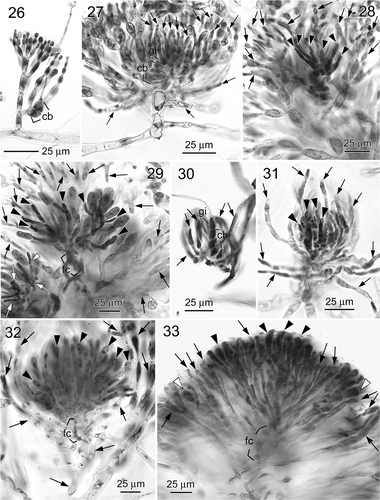Figures & data
Table 1. List of species of the Liagoraceae used for rbcL analysis in this study and their GenBank accession numbers.
Fig. 1. RbcL phylogeny: ML tree (ln L = –10165.9564) of the proposed new genera Neoizziella and Macrocarpus from the northwestern Pacific Ocean, using a selection of the related genera within the families Liagoraceae, Scinaiaceae and Galaxauraceae. Numbers above branches are ML bootstrap values, MP bootstrap values and Bayesian posterior probabilities in %, respectively. A dash indicates support values <50%.
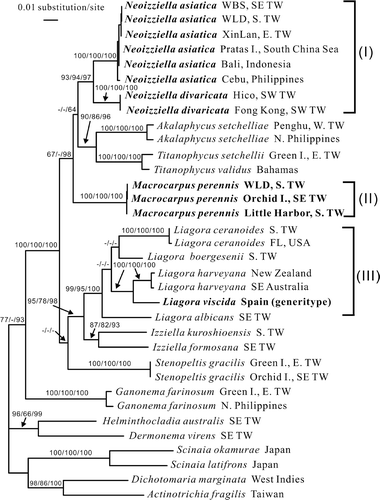
Figs 2–11. Neoizziella asiatica, sp. nov. 2. Holotype, a female plant. 3. Habit, a liquid preserved, female plant. 4. Close-up of a female plant showing branching pattern and cystocarps (arrows). 5. Young cortex showing spermatangial initials. 6. Differentiating spermatangia (arrowheads) and the discharged spermatangia (white arrows). 7. Mature spermatangia (arrowheads) in cluster. 8. Close-up of assimilatory filaments and carpogonial branches (arrows). 9. An early post-fertilization stage showing supporting cell (sc), carpogonial branch (cb), fertilized carpogonium (ca), gonimoblast initial (gi) and initials of involucral filaments (arrows). 10. Another post-fertilization stage showing supporting cell (sc), carpogonial branch (cb), fertilized carpogonium (ca), early gonimoblasts (g) and branched involucral filaments (arrows). 11. A later post-fertilization stage showing supporting cell (sc), elongated carpogonium (ca), developing gonimoblasts (arrowheads) and elongated involucral filaments (arrows).

Figs 12–15. Neoizziella asiatica, gen. et sp. nov. , . Two views of a young carposporophyte. 12. Focal plane of the involucral filaments (arrows), which surround the gonimoblasts completely. 13. Focal plane of distinct carpogonial branch (cb), the gonimoblasts (arrowheads) and the rear involucral filaments (arrows). 14. Nearly mature carposporophyte showing the gonimoblasts (arrowheads) intermingling with involucral filaments (arrows). Note that the cells of carpogonial branch (cb) are not fused. 15. Fully developed gonimoblasts bearing terminal, mature carposporangia (arrowheads). Note that the cells of carpogonial branch (cb) and the supporting cell (sc) remain distinct.
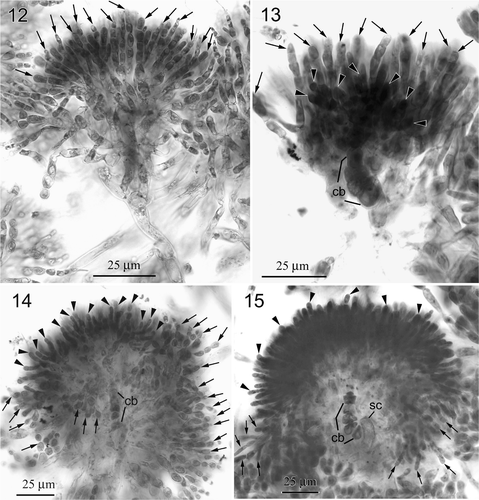
Figs 16–21. Neoizziella divaricata, comb. nov. (Hico, Pintung County, Taiwan). 16. Habit, a female plant. 17. Close-up of assimilatory filaments and a carpogonial branch (arrow). 18. An early post-fertilization stage showing supporting cell (sc), carpogonial branch (cb), gonimoblast initial (gi) and young involucral filaments (arrows). 19. A later post-fertilization stage showing carpogonial branch (cb), young gonimoblasts (arrowheads) and elongated involucral filaments (arrows). 20. Fully developed gonimoblasts (arrowheads) intermingling with involucral filaments (arrows). 21. Close of another mature cystocarp showing undivided carposporangia (arrowheads) and involucral filaments (arrows).
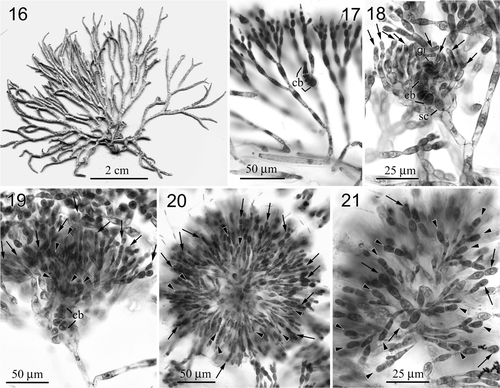
Figs 22–25. Macrocarpus perennis, gen. et comb. nov. (, : Won-Li-Dong, PinTung County, Taiwan; , : Houtou, Orchid Island, Taiwan). 22. Habit of a female plant. 23. Close-up of assimilatory filaments and carpogonial branches (cb). 24. An early post-fertilization stage showing carpogonial branch (cb), gonimoblast initial (gi), primary gonimoblasts (arrowheads) and young involucral filaments (arrows). 25. A later post-fertilization stage showing carpogonial branch (cb), gonimoblast initial (gi), young gonimoblasts (arrowheads) and involucral filaments (arrows).
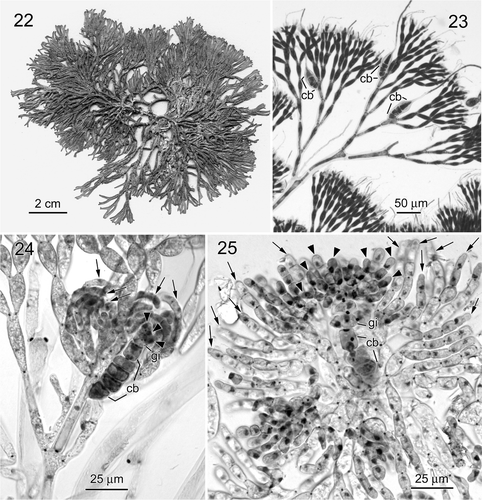
Figs 26–33. Liagora spp. . Liagora viscida (, : Cabrera, Illes Balears, Spain; , : Capraia, Tuscan Islands, Italy). 26. Close-up of assimilatory filaments and a carpogonial branch (cb). 27. An early post-fertilization stage showing carpogonial branch (cb), gonimoblast initial (gi) and young involucral filaments (arrows). 28. A later post-fertilization stage showing young gonimoblasts (arrowheads) and elongated involucral filaments (arrows). 29. Fully developed gonimoblasts (arrowheads) showing mature carposporangia, fusion cell (fc) and surrounding involucral filaments (arrows). Note that some gonimoblasts are squeezed out (white arrows). . Liagora harveyana, carposporophyte development (, , : Port Fairy, Victoria, southern Australia; : Leigh, Auckland Island, New Zealand). 30. An early post-fertilization stage showing carpogonial branch (cb), gonimoblast initial (gi) and young involucral filaments (arrows). 31. A later post-fertilization stage showing young gonimoblasts (arrowheads) and elongated involucral filaments (arrows). 32. Fully developed gonimoblasts (arrowheads) showing undivided carposporangia (arrowheads), fusion cell (fc) and involucral filaments (arrows). Note that the involucral filaments loosely surround the gonimoblasts. 33. Mature cystocarp showing divided (white arrowheads) and undivided (black arrowheads) carposporangia, fusion cell (fc) and involucral filaments (arrows). Note that the involucral filaments intermingle with the gonimoblasts.
